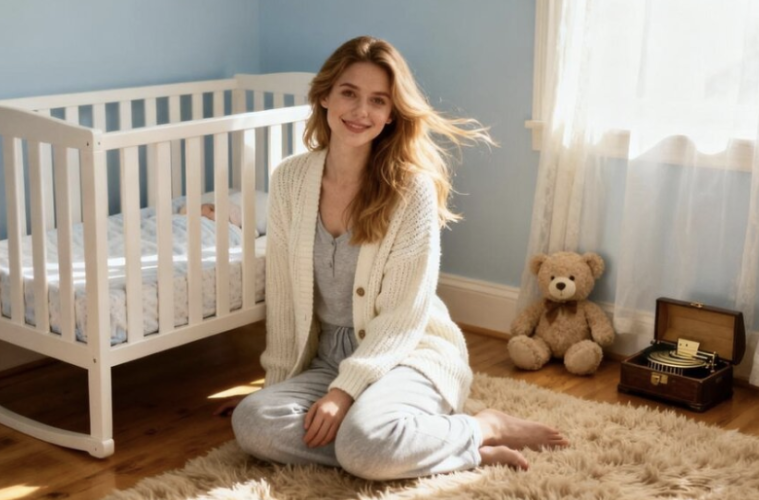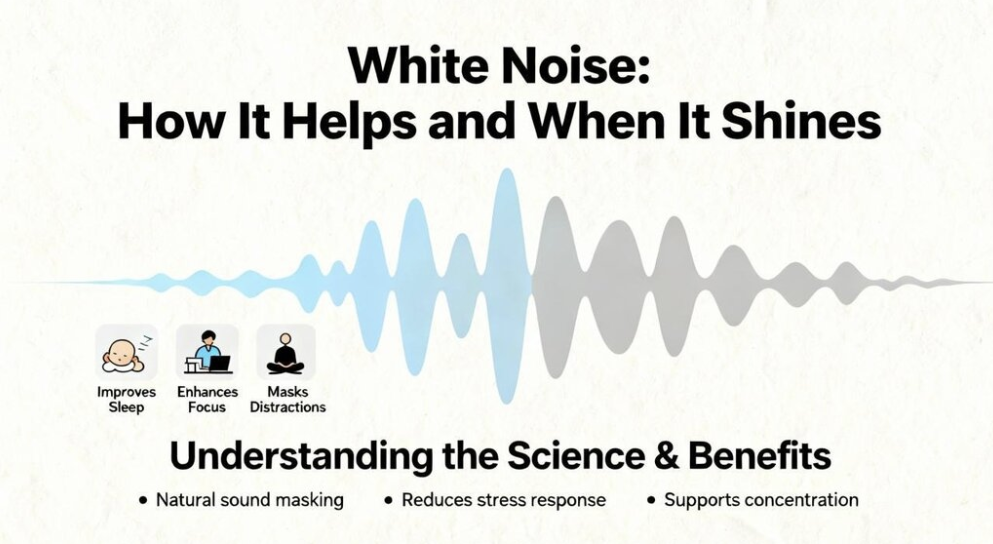As a gentle-parenting advocate and mom who has walked these midnight halls more than once, I know the moment you dim the lights and wonder, “What will actually help my baby sleep?” Two of the most trusted tools are steady white noise and soothing lullabies. Both can be nurturing, but they work differently on a baby’s still-maturing nervous system. This guide compares them with practical steps, safety guardrails, and buying advice for choosing a baby sleep noise maker you can use tonight, backed by reputable sources like the American Academy of Pediatrics, Harvard Health Publishing, The Informed SLP, and multiple pediatric sleep educators.
What “Sleep Efficiency” Means—and the Sounds We’re Comparing
When we talk about sleep efficiency for newborns, we mean how quickly a baby falls asleep and how much of their time in the crib is actual sleep rather than stirring and resettling. Because newborns cycle through lighter sleep more frequently than adults, the goal is to reduce arousals that fully wake them and to shorten the time to settle back down when wakeups happen.
White noise is a steady, patternless sound containing all audible frequencies at roughly equal intensity. In practice it sounds like a constant “shhh” or fan. Variants like pink noise and brown noise shift more energy to lower frequencies to feel deeper and less hissy, which many families find gentler during long stretches. Lullabies are organized, predictable musical patterns—often parent‑sung—that use soft dynamics, repetition, and slower tempos to help the nervous system downshift. Clinical reviews note that structured, familiar sounds at low volumes can reduce arousals and support calming, especially in very young or medically fragile infants, while more complex or changing music can become stimulating when babies are trying to stay asleep.
Evidence at a Glance
The headline on white noise is that it can meaningfully shorten sleep onset and reduce disruptive wakeups by masking household sounds and simulating the womb’s constant hum. A neonatal study from 1990 reported that about four in five newborns fell asleep within five minutes with white noise, compared with about one in four without it. A small 2018 trial in colicky infants found white noise helped babies cry less and sleep more than motion‑based soothing. Pediatric educators and clinicians often use those findings to guide early weeks and months, with the important caveat that loudness and distance matter.
Lullabies have their own strengths. A 2024 scoping review summarized by The Informed SLP reported that low‑volume, “organized” sounds, including lullabies, heartbeat‑like rhythms, or metronome‑paced audio, are associated with better infant sleep quality. In neonatal intensive care units, studies describe benefits from gentle music or parent‑sung lullabies, including more stable heart rates, improved feeding efficiency, and perceived reductions in parental stress and anxiety. Because lullabies are inherently social, they pull double duty for bonding and regulation, which is especially valuable during the bedtime routine.
Harvard Health Publishing points out that white noise evidence is mixed across ages and that continuous noise might disrupt deeper sleep stages for some people. The American Academy of Pediatrics warns that many infant sound machines can exceed safe levels at maximum settings, urging families to keep volume low and devices far from the crib. The Informed SLP likewise notes that some apps can be surprisingly loud and that quieter, shorter, and further away is better for developing ears. This is where setup details can matter as much as the sound itself.
White Noise: How It Helps and When It Shines
Newborns arrive from a very noisy environment. Some parenting and sleep sources estimate that the womb’s swirl of blood flow and body sounds can feel as loud as a vacuum cleaner, and others note it can reach or exceed about 90 dB at times. The steady wash of white or pink noise recreates that sonic blanket while masking door clicks, dishes, dogs, and traffic that otherwise pierce light sleep. In my own home, a consistent, low, rumbling sound helped my babies fall back to sleep after brief stirrings, especially when I had a preschooler and a very enthusiastic Labrador in the mix.
White noise is also a powerful cue. When you turn it on the same way before naps and bedtime, babies quickly learn, “This sound means sleep.” The most practical use is to play a low, steady track throughout the entire sleep period, not just to fall asleep, so abrupt household sounds don’t become wake triggers a few cycles later. Pink or brown variants often feel softer to adult ears and may be kinder for all‑night use, while brighter white noise can be useful during the settling window for a fussy newborn.
Safety and Setup for White Noise
Every reputable source converges on the same core guidance: keep volume modest and the device far from baby. The American Academy of Pediatrics has highlighted that some infant sound machines can exceed recommended levels at maximum settings. Their practical advice is to place any sound source about 7 ft from the crib and use the lowest effective volume, which many educators equate to the level of a quiet conversation or a running shower when you do not need to raise your voice. Harvard Health echoes the keep‑it‑low guidance, suggesting families consider whether the sound is needed all night or mainly at sleep onset. The Informed SLP emphasizes that phones and certain apps can be much louder than you expect, so distance and measurement matter.
A decibel meter app can be a useful spot‑check, but because readings vary, a quick conversational test is surprisingly reliable. Stand next to the sleep space while the sound is on and confirm you can carry on a normal conversation without raising your voice. As an added postpartum sanity tip, keep the sound low enough that you can still hear early hunger cues, movement, or changes in breathing. For phones, airplane mode avoids notifications, and placing devices far from the crib avoids hot spots of sound.
When White Noise Can Backfire
Problems tend to come from loudness, proximity, and overuse. If a machine sits close to the crib or runs at high levels for long overnight stretches, the intensity can exceed what is recommended for growing ears. Studies summarized by The Informed SLP cite that many devices and apps can reach adult occupational thresholds at close range, which are not considered safe targets for infants. Overreliance is another friction point. If the exact sound is unavailable at daycare, on trips, or during power outages, some babies protest. The good news is that you can treat white noise as a helpful association, not a crutch. Families often wean by gradually lowering the volume over a week or two once sleep is solid, or by keeping a travel‑friendly device on hand so the sound stays consistent across locations. If the hissy edge of white noise bothers you or your baby, choose a deeper pink or brown profile. If your baby startles despite the noise, re‑check placement and move the device between the crib and the common noise source.
Lullabies: How They Help and Where They Excel
Lullabies are more than sweet tradition. They are an elegant tool for co‑regulation. The structure, repetition, and gentle dynamics nudge the parasympathetic system, which is the body’s rest‑and‑digest pathway. The Informed SLP’s summary of a recent scoping review reports that low‑volume, organized sound can improve infant sleep quality. In hospital settings, soft music and parent‑sung lullabies have been linked to calmer vitals and better feeding organization for preterm babies, and parents often report feeling less stressed and more connected when singing or humming. A consumer health overview from Women’s Choice Award also notes that soft, repetitive melodies can slow heart rate and deepen breathing patterns, which fits what many of us observe at home in the minutes before a good swaddle and feed.
The art of lullabies is restraint. Highly varied music, sudden dynamic shifts, or catchy tunes with strong lyrics can invite attention, which is wonderful for playtime but unhelpful for sustaining sleep. A report from the UNSW Empirical Musicology Lab argues that music’s complexity can stimulate arousal, while broadband noise is better at masking disruptions. That does not mean music cannot support sleep. It suggests that simple, slower, quieter, and repetitive lullabies are the right fit for bedtime routines, and that continuous masking sounds do a better job once a baby is actually asleep.
Best Practices for Lullabies
Think of singing as the heart of your bedtime routine rather than the soundtrack of the entire night. Keep the volume low, choose simple and repetitive melodies, and aim for tunes you can comfortably hum without straining. The voice is a powerful regulator for babies, and it also supports bonding during those tender postpartum weeks when everyone is learning each other’s rhythms. If you use a device, pick tracks that do not include dramatic crescendos, percussion breaks, or theatrical sound effects. Play lullabies only during the wind‑down and then switch to a steady, low hum of white or pink noise if you want ongoing masking. Avoid placing speakers near the crib, and keep cords secured and out of reach. If you rely on a baby monitor with built‑in lullabies, test the lowest volume settings and confirm the unit sits far from the sleep space.
When Music Hinders Sleep
If you notice your baby startles during a musical transition, fixates on the tune, or wakes fully when a loop ends and restarts, the music is doing too much. Some babies are so socially wired that a singing voice calls them into interaction, especially by 3 to 4 months when alertness blooms. In those cases, keep lullabies earlier in the routine and lean on constant sound during actual sleep. Harvard Health notes that continuous noise might disrupt deeper sleep in some people, so if you suspect musical background tracks all night are fragmenting rest, experiment with turning them off once your baby is asleep while keeping a gentle masking sound in the room. This is an area where tuning to your baby matters as much as any guideline.
Side‑by‑Side Comparison
| Aspect | White Noise | Lullabies | Evidence Snapshot | Safety Notes |
| Primary role | Masks environmental sounds and smooths sudden changes to protect sleep cycles. | Down‑regulates and bonds during wind‑down; cues the body to relax. | Neonatal study reported about 80% fell asleep within 5 minutes with white noise versus about 25% without; colic trial showed less crying and more sleep with white noise than motion soothing. Reviews note low‑volume organized sounds improve infant sleep quality. | AAP highlights volume and distance; devices can exceed safe levels at max. Keep far and low. Lullabies should be soft and simple; avoid stimulating tracks. |
| Best timing | During the entire sleep period for consistent masking, and optionally during settling. | During the bedtime routine and early soothing, then fade out. | The Informed SLP’s review favors low‑volume, structured audio for calming; masking benefits are widely reported across pediatric sleep educators. | Keep white noise low enough to hear hunger cues; keep music brief to avoid stimulating wakeups. |
| Sensory profile | Patternless, steady “shhh,” with pink and brown variants sounding deeper. | Predictable melody and rhythm; ideally slow and repetitive. | UNSW report argues broadband noise masks better than complex music for sleep maintenance. | Choose continuous, non‑looping sounds; avoid dramatic musical changes near sleep. |
| Practical tradeoffs | Strong at blocking noise; risk of dependency if the exact sound is not available when traveling. | Strong for bonding; risk of stimulating attention if music is complex or too loud. | Harvard Health notes mixed evidence overall; personalization matters. | Keep both low and distant; treat them as tools rather than must‑haves. |
Setup Targets and Troubleshooting
| Parameter | White Noise | Lullabies |
| Volume guidance | Aim for the lowest effective level, roughly the loudness of a quiet conversation or running shower. Many educators reference about 50 dB as a safe sleep target. | Keep very soft, far below conversation level; lullabies should be clearly audible to you but not dominate the room. |
| Distance | Place about 7 ft from the crib whenever possible. If you must place a portable unit closer for a stroller nap, drop the volume to a whisper. | Keep speakers far from baby, with cords secured and no devices in the crib. |
| Duration | Run continuously through sleep to mask disruptions, or test a timer if your baby sleeps fine without all‑night sound. | Use during the wind‑down only, then fade out before or just after lights‑out. |
| Device placement | Between the crib and the common noise source, not behind the crib or on the mattress. | Outside the crib on a stable surface; avoid plush “speaker toys” in the sleep space. |
| Quick safety check | Hold a normal conversation at arm’s length without raising your voice; if you cannot, it is too loud. | Listen for sudden changes or song loops that might wake a dozing infant; simplify or shorten if needed. |
Buying Tips and Care
A dedicated sound machine with continuous, non‑looping white or pink noise and precise volume control is the easiest option for most families. Look for a model that can play all night without auto‑off timers, has fine‑grained volume steps, and does not add bright lights to the nursery. If a unit has a nightlight, confirm it can be fully disabled or dimmed to an amber hue. Analog fan‑based machines can sound smooth and natural, while digital models often add pink and brown options. A battery backup or portable unit helps during travel and power outages. For safety, place the machine on a stable surface, at adult‑chest height or higher if cords are in reach, and route cords behind furniture or through cord covers to prevent tugging.
If you prefer lullabies, consider where the audio originates. Smart displays and monitors often include lullaby libraries, but their speakers can be surprisingly loud at close range. Explore the lowest settings and set the device far from baby. If you use a cell phone, enable airplane mode and place it well away from the crib. Keep playlists simple and slow, and test for seamless loops so a restart does not wake a drowsy newborn. Wipe speaker grilles periodically to prevent dust build‑up that can distort sound, and review settings after every room move; distance can unintentionally shrink after a furniture shuffle.
Gentle‑Parenting, Postpartum, and Breastfeeding Considerations
Newborn care is a teamwork sport, and you are part of the equation. White noise, at a low level, can protect your rest, your partner’s rest, and the sleep of siblings without drowning out hunger cues. I remind families that feeding rhythms, burping, and diaper changes need to fit inside a ritual that is repeatable while your postpartum body heals. For breastfeeding, keep the sound low enough to hear early cues and adjust for cluster feeding evenings when you will be in and out of the room. If you find white noise helpful for your own sleep, do not hesitate to run a quiet machine in your room too; many adults report sleeping more soundly with steady sound and fewer awakenings to neighborhood noise.
Gentle parenting values connection. A few minutes of holding and singing can be the emotional bridge from daylight to sleep, especially after stimulating late‑afternoon hours. If your baby revs up with singing and locks eyes like it’s time to party, move the lullaby earlier and let a steady noise take over during the final sway or feed. In calmer stretches of the fourth trimester, skin‑to‑skin during a soft song can be the most effective regulator of all. Your presence matters more than the tool.
Routine Ideas You Can Try Tonight
A workable bedtime sequence is often as simple as change, feed, sing, and settle. After a warm change, offer a full feed, pause for gentle burps, and dim the lights. If you sing, keep the same two or three songs each night so your baby knows what is coming next. Place the baby down drowsy, turn on a steady low sound at a distance, and take a slow breath before you step away. If your home is lively in the early evening, consider starting the wind‑down 15 minutes earlier so you are not rushing against household noise. During daytime naps, follow a shorter version of the same ritual and let the sound cover dishes and doorbells so you can move around your home without tiptoeing.
Putting It All Together
A simple rule of thumb I share with families is to use lullabies for connection before sleep and white or pink noise for protection during sleep. If your baby struggles with colic or short naps, lean more on steady noise at night and during naps, and let singing shine at the start of the bedtime routine. If your baby is sensitive to sound or easily overstimulated, simplify the music and shorten it to a minute or two. Keep both options low and far, and make changes gradually so associations stay positive. The evidence base in infants is growing but still modest, and individual differences are real. What matters is what consistently helps your baby and your family rest, while staying within safe guidelines.
Key Takeaway
Both white noise and lullabies can support newborn sleep efficiency when used thoughtfully. White noise excels at masking disruptions and shortening sleep onset, with neonatal and colic studies backing its utility, while lullabies support calming, bonding, and smoother vitals in fragile infants when kept soft and simple. Follow the American Academy of Pediatrics’ guidance to place sound machines about 7 ft from the crib and keep volume low, use lullabies during the wind‑down rather than all night, and personalize the plan to your baby’s cues. The safest and most sustainable approach is usually a gentle blend: sing to connect, and let a quiet, steady sound stand guard while everyone sleeps.
FAQ
Is white noise safe for newborns all night long?
White noise can be used through the entire sleep period if you keep the volume low and the device distant. Pediatric sources, including the American Academy of Pediatrics, caution that many machines exceed safe levels at maximum settings. Place the device about 7 ft from the sleep space, keep the volume at the lowest effective level, and make sure you can hold a normal conversation in the room without raising your voice. If your baby sleeps soundly without all‑night sound, you can use it just for settling and turn it off.
Can lullabies play all night instead of white noise?
It is better to use lullabies for the wind‑down ritual and then fade them out. Musical patterns are “organized” sounds that can calm babies, but changes in pitch, tempo, and dynamics may stimulate attention during light sleep or when a loop restarts. Clinical reviews summarized by The Informed SLP suggest low‑volume structured audio supports calming, while masking sounds are more effective at smoothing disruptions once a baby is asleep.
What volume and distance should I use if I only have a portable unit?
Keep a portable device at a whisper and as far away as your setup allows. For stroller or car‑seat naps, place the unit at the lowest volume that still masks ambient noise and turn it off when your baby wakes. When you are home, shift back to a machine placed about 7 ft away. Because phones and small speakers can be louder than expected at close range, prioritize distance over loudness.
My baby seems to “need” white noise to fall asleep. How do I prevent dependency?
Treat white noise as a helpful association you can dial up or down. Once sleep is going well, lower the volume a little every night for a week or two. You can also keep it off during the first minutes of bedtime so your baby falls asleep without it, then turn it to a quiet setting later to protect the early‑morning hours when sleep is lighter. Carry a small, familiar‑sounding device for travel so the sleep environment stays consistent away from home.
Is pink or brown noise better than white noise?
Many families prefer pink or brown noise for overnight use because both shift energy toward lower frequencies and sound deeper and less hissy. The masking benefit remains, and adult studies suggest lower‑frequency noise can feel more restful. Infant‑specific evidence is limited, so this is a preference call. If the brighter hiss of white noise bothers you or your baby, try a deeper profile at the same low volume.
Will white noise or music affect my baby’s hearing or language development?
Risk stems from too much loudness for too long at too close a distance, not from safe, sleep‑only use. Reviews summarized by The Informed SLP note that some devices and apps can produce levels that would be considered hazardous over a full night at close range, and Harvard Health flags mixed sleep outcomes with continuous noise. Keep sounds low, keep devices distant, and turn all audio off during awake time so your baby hears your voice and the natural sounds of home. If you have specific concerns, ask your pediatrician or a pediatric audiologist.
A Note on Sources and Confidence
This article draws on guidance and summaries from the American Academy of Pediatrics, Harvard Health Publishing, The Informed SLP, pediatric sleep educators such as Taking Cara Babies and Huckleberry, clinical and consumer health overviews from UPMC and What to Expect, and a report from the UNSW Empirical Musicology Lab comparing white noise and music. The neonatal and colic studies cited are small but informative for early weeks; broader conclusions about all‑night use across ages remain mixed, so personalization is key. Where I suggest combining lullabies for connection and white or pink noise for masking, that recommendation reflects both the cited evidence and common clinical practice; confidence is medium because individual variability is high.
Published by HOLR Magazine.





